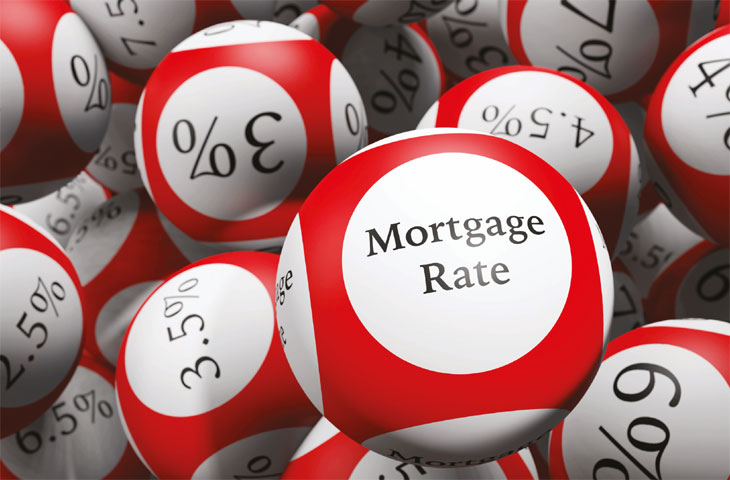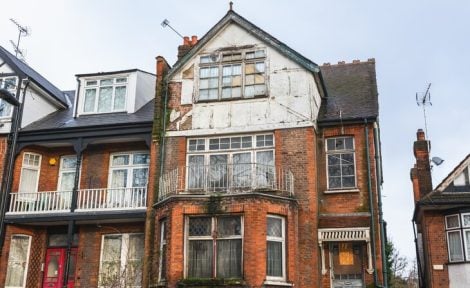The lending lottery
It’s been a volatile six months for mortgage rates. Richard Reed asked a team of experts to indicate where they think rates might be heading.

Then, in early March, there were signs that all was not well. The interest rates on swaps – used by smaller banks to finance lending – started to rise once more. Mortgage rates started to creep up again. Central banks said inflation might be more ‘baked in’ than had been thought.
Jerome Powell, chairman of the US Federal Reserve, said he would have no hesitation in increasing rates if necessary, a warning echoed by the European Central Bank.
Have rates peaked?
 So where does that leave the outlook for mortgage rates in 2023? Is there more to go, or have they peaked? “That was my view until a few weeks ago but I think we have kicked things out a bit further now,” says Jeni Browne, Sales Director at Mortgages for Business, a broker focused on the buy-to-let (BTL), commercial and bridging market.
So where does that leave the outlook for mortgage rates in 2023? Is there more to go, or have they peaked? “That was my view until a few weeks ago but I think we have kicked things out a bit further now,” says Jeni Browne, Sales Director at Mortgages for Business, a broker focused on the buy-to-let (BTL), commercial and bridging market.
The official line is that we will see rates increase to 4.5%, that should then be the cap for the rest of this year, and we may see base rates start to ease back down in Q2 2024. Jeni Browne, Mortgages for Business.
“The official line from the business is that we will see rates increase to 4.5%, that should then be the cap for the rest of this year, and we may see base rates start to ease back down in Q2 2024.” She doesn’t see rates declining at all this year. “Swap rates have been sitting at around 3.5% for quite a while but they started bubbling up again in the past couple of weeks and are now sitting at more like 4%.
“It seems to be market nerves around eurozone inflation and the fact they hadn’t quite appreciated how bad things were there, so they undercooked their inflation situation and are going to have to hype their rates. But also, the news about the US and core inflation being much higher than expected and they might have to push their rates up.”
Browne says the market is diverging, depending on the size of the lender. “Swap rates have gone up, so for lenders who rely on the money markets, their costs have gone up so their pricing should also increase. But not all lenders are funded entirely by the money markets. Many lenders are also deposit-taking institutions, so these guys are less affected by the cost of funds on the wholesale market.
“When we have been tracking fixed-rate price movements over the past few weeks, what we have seen is a lot of high street institutions – Skipton, The Mortgage Works, BM Solutions, Virgin, NatWest – all these guys have actually been reducing their rates, whereas the specialist lenders – Precise, Paragon, those kind of institutions who don’t have the same kind of balance sheet, these guys have gone very quiet on rate reductions and some have started pricing back up again.
“Overall, the message is we will see fixed rates go up over the next few weeks, but different lenders will react at different rates because of the way they are funded.”
‘Rates will be higher for longer’
 Peter Beaumont, CEO of The Mortgage Lender (TML), a specialist bank focusing on the self-employed and limited companies, agrees that rates will be higher for longer to make sure underlying inflation is firmly under control. “That’s why you’ve seen the swap rates go back up. Inflation is a bit stubborn and the BoE has no economic necessity to bring rates down, so they will leave them up longer. We think there is a possibility of another increase – 0.25% to 0.5% on base rate,” he notes.
Peter Beaumont, CEO of The Mortgage Lender (TML), a specialist bank focusing on the self-employed and limited companies, agrees that rates will be higher for longer to make sure underlying inflation is firmly under control. “That’s why you’ve seen the swap rates go back up. Inflation is a bit stubborn and the BoE has no economic necessity to bring rates down, so they will leave them up longer. We think there is a possibility of another increase – 0.25% to 0.5% on base rate,” he notes.
The BoE has no economic necessity to bring rates down, so they will leave them up longer. We think there is a possibility of another increase – 0.25% to 0.5% on base rate. Peter Beaumont CEO, The Mortgage Lender.
He agrees with Browne that small, specialist non-bank lenders are struggling, as they rely on the swap markets to raise finance. Big lenders sitting on large pots of cash in current and savings accounts are less affected by swap rates.
So will interest rates fall at all this year? “I would like to think interest rates might start falling towards end of year, but it’s quite a bet at the moment,” he says. “If you had asked me two months ago I would have said yes, because everything was showing rates coming down, but that has been reversed in the past few weeks. This is the most volatile I have seen it since that Mini-Budget.”
Beaumont says the uncertainty has led to a revival of the tracker mortgage: of the total market at the moment, 86% is on a fixed rate (42% is two-year, 51% five-year) and 14% on a tracker. “With trackers, people are taking a bet that rates are going to come down,” he explains – TML is looking at launching its own tracker product shortly.
There has also been a sharp increase in higher fee products aimed at those operating through a limited company, such as portfolio landlords – effectively subsidising the interest rate. In these cases, the fee can be offset against tax. About a third of that market is now at the higher fee level.
At the moment the market is predominantly focused on re-mortgaging rather than purchases, both in residential and BTL – in fact it’s running at 70% of the total in BTL. Those landlords still buying rental properties are being cautious, typically looking for higher grade energy-performance-certificate (EPC) property, so they don’t have a “cliff-edge” in 2025, when the government plans to raise the EPC threshold to grade C. “What the landlords are doing is pricing in the cost of the upgrade and knocking that off the price,” he explains.
Base rates likely to rise again
 Over at the Mortgage Advice Bureau (MAB), deputy CEO Ben Thompson says predicting interest rates is “a mug’s game”, but adds, “For the near term at least, it’s safe to say we may not have seen the last of the bank base-rate increases. If they do rise again, once they do, they will most likely be at or very near the cycle peak by then.”
Over at the Mortgage Advice Bureau (MAB), deputy CEO Ben Thompson says predicting interest rates is “a mug’s game”, but adds, “For the near term at least, it’s safe to say we may not have seen the last of the bank base-rate increases. If they do rise again, once they do, they will most likely be at or very near the cycle peak by then.”
With most economists predicting we are entering a recession, albeit one that is not as deep as predicted, so the BoE is expected to reduce its base rate to stimulate growth. Scott Clay Head of Introducers, Together.
He believes fixed rate products are likely to harden in the near term due to the recent swap rate increases. “Competition amongst lenders for market share in a gross lending market that is predictably proving to be smaller than forecast will be fierce, and to a degree that will mean pricing stays as competitive as it can do throughout 2023,” he notes. Thompson says forecasting beyond the next six months is “nigh on impossible”.
It’s not turning out as bad as we thought. People were saying the market could be down 10% or 15%, whereas it could top out at 5% down.
“Either rates have settled at and around a new level, which by way of comparison remains lower than pricing pre-credit crunch in 2007 – or, if the Bank of England overacts in a bid to stamp out inflation and the base rate rises a fair bit more, it’s almost inevitable rates will fall again in the medium term as inflation starts to fall more demonstrably quickly back down to tolerable levels.”

 Scott Clay, Head of Introducers at specialist lender Together, observes, “Times are uncertain, with most economists predicting we are entering a recession, albeit one that is not as deep as previously predicted, so the Bank of England is expected to reduce its base rate to stimulate growth in the economy once inflation is closer to its benchmark target of 2%.” He agrees that trackers are likely to increase in popularity, due to the uncertainty. “We have not seen many good tracker products since the financial crash of 2008 but I’d expect to see more of these on the market, offering more choice for borrowers,” he says. However, he warns, “Anyone taking out a tracker mortgage will need to be mindful of the fact its rate could also go up, which is a possibility if there are any more major shocks to the economy.” A rate forecast for 2023 So, pinning our experts down, where do they think mortgage rates and the housing market will end up this year?
Scott Clay, Head of Introducers at specialist lender Together, observes, “Times are uncertain, with most economists predicting we are entering a recession, albeit one that is not as deep as previously predicted, so the Bank of England is expected to reduce its base rate to stimulate growth in the economy once inflation is closer to its benchmark target of 2%.” He agrees that trackers are likely to increase in popularity, due to the uncertainty. “We have not seen many good tracker products since the financial crash of 2008 but I’d expect to see more of these on the market, offering more choice for borrowers,” he says. However, he warns, “Anyone taking out a tracker mortgage will need to be mindful of the fact its rate could also go up, which is a possibility if there are any more major shocks to the economy.” A rate forecast for 2023 So, pinning our experts down, where do they think mortgage rates and the housing market will end up this year?
If the BoE overacts in a bid to stamp out inflation and the base rate rises a fair bit more, it’s almost inevitable rates will fall again in the medium term as inflation starts to fall. Ben Thompson CEO, Mortgage Advice Bureau.
Jeni Browne: “If things do bubble up a little bit it’s not going to be huge, 0.2%, 2.3%; likewise with house prices – the general consensus is it’s going to be a 5% reduction on price this year and then it will start to recover. I think a lot of people are watching and waiting to see what happens, and that’s holding back transactions. “If it caps out at 4.5% I will be happy; I don’t think we will see a quick recovery because of the variables that are at play here.”
Peter Beaumont: “There is a bit more to go on the bank base rate to make sure we control inflation, but that won’t necessarily percolate down into increased mortgage rates. I’m hoping that mortgage rates are perhaps towards their peak, if not broadly stabilised.”
Scott Clay: “Based on what we know, rates will probably start falling in six to 18 months.”
Ben Thompson: “If I was a betting man – and I’m not – I think fixed rates are quite close to their new normal, and although they may ebb and flow a little from this point, I don’t see rates going back to where they were 18 months ago. We are all rapidly becoming accustomed to that view, I think, and as soon as homeowners and prospective buyers attune to this and confidence returns, our market will gently get going again.”
Consensus
Overall, then, the consensus is that we have come a long way from last Autumn’s Mini- Budget, and that once inflation is under control, interest rates should start heading down.
As for house prices, the good news for agents is that no-one thinks the market is in freefall. Let’s leave the last word to Peter Beaumont. “It’s not turning out as bad as we thought it might. A lot of people were saying it could be 10% or 15% down, whereas actually, we are seeing it as being much more marginal and could maybe top out at 5% down, which only takes you back to 2021.” And if that makes homes more affordable, “that’s a good thing”.
BUY-TO-LET – ALIVE AND RISING

Despite rising interest rates, the buy-to-let (BTL) sector has seen product choice rise to levels not seen since last summer, according to analysis by Moneyfacts.co.uk. Overall buy-to-let product availability, both fixed and variable, has improved month on month, returning to levels not seen since August 2022, when there were 2,375 different deals on offer.
 Rachel Springall, Finance Expert at Moneyfacts.co.uk, believes it is encouraging to see BTL product choice gradually recovering from the shock surrounding the Mini-Budget. “The choice of deals to landlords plummeted and both the average two and five-year fixed rates rose to 6% towards the tail end of 2022, but thankfully, both rates have slowly dipped below this level, she says. “There are now 2,400 deals for landlords to choose from, up from just 988 in October 2022, thanks to consecutive months of growth.
Rachel Springall, Finance Expert at Moneyfacts.co.uk, believes it is encouraging to see BTL product choice gradually recovering from the shock surrounding the Mini-Budget. “The choice of deals to landlords plummeted and both the average two and five-year fixed rates rose to 6% towards the tail end of 2022, but thankfully, both rates have slowly dipped below this level, she says. “There are now 2,400 deals for landlords to choose from, up from just 988 in October 2022, thanks to consecutive months of growth.
There are now 2,400 deals for landlords to choose from, up from just 988 in October 2022.
“The drop in average buy-to-let rates appear more subdued than seen within the residential mortgage sector, but lenders have made moves to entice new business, despite some investors’ concerns surrounding rental income margins.”
However, she added a cautionary note, observing that both the average two- and five-year fixed rates are above 5%, compared with roughly 3% a year ago. “It’s clear that landlords are likely to see their monthly repayments much higher than they perhaps anticipated,” she states. “There may even be those looking to sell up this year because of the rise in interest rates, tax changes for holiday lets and capital gains tax, or even EPC requirements – all of which dampen profit margins or investment returns on the sale of a property.”





